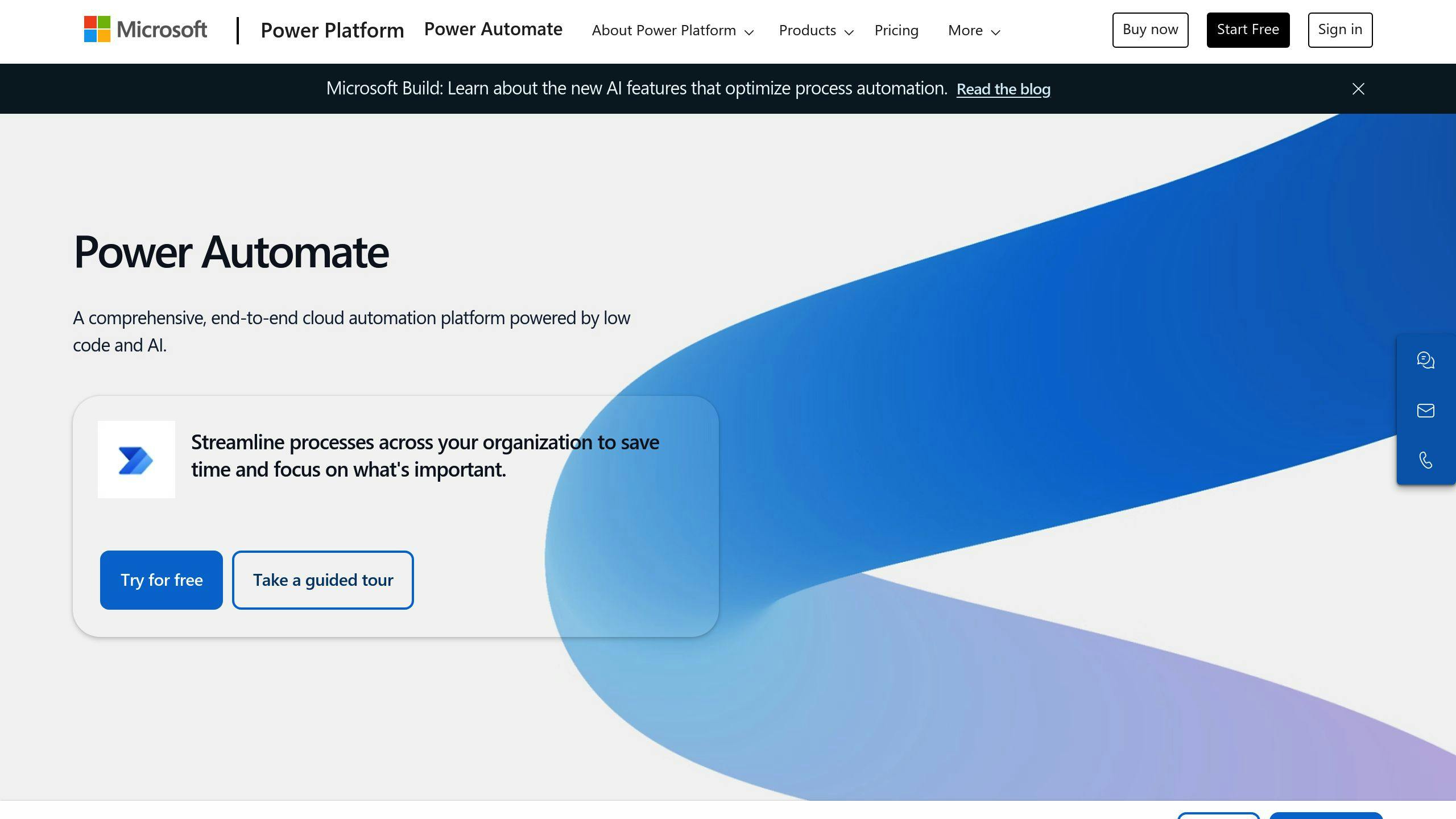Automate your file tasks in Teams using Power Automate. Here’s what you need to know:
- Power Automate integrates with Teams to streamline file management
- You can create flows for file creation, moving, copying, and deletion
- Connects Teams with SharePoint and OneDrive for seamless workflows
Key benefits:
- Saves time
- Reduces errors
- Ensures compliance
- Improves teamwork
To get started:
- You need an active Teams account and Power Automate access
- Find Power Automate in Teams Apps
- Use pre-built templates or create custom flows
Common file management flows:
| Flow Type | What It Does | Why It’s Useful |
|---|---|---|
| Auto-Create | Generates files based on triggers | Ensures consistent file creation |
| Auto-Move | Relocates files to correct folders | Keeps files organized without manual effort |
| Auto-Delete | Removes old or unnecessary files | Maintains a clean workspace |
| Auto-Rename | Changes file names based on content | Makes files easier to locate |
Remember: Always consider security and permissions when setting up flows. Start with simple automations and build complexity as you get comfortable.
With these tools, you’ll be managing files like a pro in no time.
Related video from YouTube
What You Need to Start
To create file management flows in Microsoft Teams, you need:
- A Microsoft Teams account
- Power Automate access
Microsoft Teams Account

You need an active Teams account with the right permissions:
- Active account
- Team owner or member permissions
- Access to relevant channels
Power Automate Access

You also need Power Automate access:
- Valid Power Automate license
- At least Environment Maker role
- Access to your organization’s Power Automate environment
| Requirement | Teams | Power Automate |
|---|---|---|
| Account | Active | Valid license |
| Permissions | Owner/Member | Environment Maker or higher |
| Access | Relevant channels | Correct environment |
Don’t have what you need? Talk to your IT admin.
How Power Automate Works with Teams
Power Automate and Microsoft Teams team up to make file management a breeze. You can set up automated workflows right in Teams, saving you time and hassle.
Why Use Both Tools?
- They work together seamlessly
- You can automate boring tasks
- Your team stays in the loop
- Your files stay organized
Here’s what you can automate:
| Task | What it does | Why it’s great |
|---|---|---|
| Document routing | Moves files to the right folders | Keeps things tidy |
| Approval workflows | Sets up multi-step approvals | Speeds up decisions |
| Version control | Tracks changes | Makes file history easy |
| File backup | Copies important files | Protects your data |
| Categorization | Tags files automatically | Makes finding stuff easier |
Want to start? Here’s how:
- Open Teams
- Go to Apps
- Find "Workflows"
- Pick a template or make your own flow
All your flows live in your organization’s default environment. It’s like a central hub for all your automated processes.
Getting Ready to Create Flows
Let’s set up Power Automate in Microsoft Teams to start making file management flows. Here’s what you need to do:
Finding Power Automate in Teams
- Open Microsoft Teams
- Click Apps in the left sidebar
- Search for "Power Automate"
- Click Add for me
- Pick your country/region and hit Get started
Want quick access? Pin the app by right-clicking it in the sidebar and selecting Pin.
Using the Workflows App
The Workflows app in Teams has pre-built templates for common tasks:
- Go to Apps in Teams
- Select Workflows from the left menu
- Browse the workflows
- Pick one and follow the prompts
Can’t find Workflows? It might be uninstalled. Just search for it in the app store and add it.
Here’s a quick look at some workflow types:
| Workflow Type | What it Does | Why it’s Useful |
|---|---|---|
| Document routing | Moves files to right folders | Keeps things tidy |
| Approval workflows | Sets up multi-step approvals | Speeds up decisions |
| Version control | Tracks file changes | Easy file history |
| File backup | Copies important files | Protects your data |
| Categorization | Tags files automatically | Makes finding files a breeze |
Your flows are stored in your organization’s default environment. Think of it as a central hub for all your automated processes.
Making Simple File Management Flows
Let’s create basic file management workflows in Microsoft Teams using Power Automate. These flows will automate routine tasks and save you time.
Creating Files Automatically
Here’s how to set up a flow that generates files based on specific events:
- Open the Workflows app in Teams
- Click "Create a flow"
- Choose "When a new item is added to a SharePoint list" as the trigger
- Select "Create file" as the action
- Pick the destination folder and set file properties
Example: Create a new project brief document when a new project is added to your SharePoint list.
Moving and Copying Files
To automate file organization:
- In the Workflows app, select "Create a flow"
- Choose "When a file is created" as the trigger
- Add a "Copy file" or "Move file" action
- Set the source and destination paths
Pro tip: Use dynamic content to set file paths based on metadata like project name or client.
Deleting Files Automatically
Keep your Teams workspace clean by removing old files:
- Start a new flow in the Workflows app
- Select "Scheduled" as the trigger type
- Set the frequency (e.g., weekly)
- Add a "Get files" action to retrieve files
- Use a "Condition" to check file age
- Add a "Delete file" action for old files
Warning: Be careful with automatic deletion. Double-check your conditions to avoid losing important data.
sbb-itb-8be0fd2
More Complex File Management
Let’s take your Microsoft Teams file management to the next level with some advanced techniques.
Renaming Files Automatically
Tired of manually renaming files? Let Power Automate do it for you:
1. Create a new flow in Power Automate 2. Set "When a file is created" as the trigger 3. Add a "Rename file" action 4. Use dynamic content for the new file name
Here’s a cool trick: rename project briefs to include the current date:
"Project Brief - {formatDateTime(utcNow(), 'yyyy-MM-dd')}.docx"
This turns "NewBrief.docx" into "Project Brief – 2023-05-15.docx". Neat, right?
Converting File Types
Need a PDF? Power Automate can convert Word docs for you:
1. Start with "When a file is created" 2. Add "Convert Word to PDF" 3. Set input file and output location
| From | To |
|---|---|
| Word (.docx) | PDF (.pdf) |
Don’t forget to add error handling. Conversions can be tricky sometimes.
Smart File Actions
Make your file management smarter with conditional actions:
1. Trigger: New file created 2. Get file content 3. Check content with a condition 4. Move file or send email based on the result
For example, move files marked "Confidential" to a secure folder:
If file has "Confidential"
Move to "Secure Documents"
Else
Keep it where it is
These advanced techniques can save you tons of time and keep your files organized without lifting a finger. Give them a try!
Connecting with Other Microsoft 365 Apps
Power Automate links Teams file management with other Microsoft 365 apps. Here’s how:
Working with SharePoint
Teams and SharePoint are best buddies. Create a Team, get a SharePoint site. Simple.
- Files shared in Teams? They’re in SharePoint too.
- SharePoint file tools? Use ’em right in Teams.
Want to add SharePoint stuff to Teams? Just copy-paste a page link as a new tab in your channel. Need more? Add entire document libraries to Teams for quick file access.
Using OneDrive in Your Flows
OneDrive plays nice with Teams workflows. Try this:
1. Open Power Automate in Teams
2. Pick "Save Office 365 email attachments to OneDrive" template
3. Choose emails to watch (like important ones)
4. Select an OneDrive folder for attachments
Now, key email files automatically land in OneDrive for your team.
"We set up a flow to save client project briefs to a shared OneDrive folder. Our team at Eleviant CTG cut file-finding time by 40%. It’s been a game-changer for project starts", said the company’s CPO.
This setup streamlines workflows and saves time. Give it a shot.
Tips for Good File Management Flows
Keeping Flows Organized
Want to keep your Microsoft Teams file management flows neat and usable? Here’s how:
- Use a production environment: Set up your daily-use flows here. It’s more stable and makes updates easier.
- Name flows clearly: Start production flow names with "[PROD]". It’s a quick way to spot them.
- Group flows with solutions: Use the Solutions tab in Power Automate. It’s like creating folders for your flows.
- Add backup owners: Give 2-3 people co-owner status. If you’re out, someone can still fix issues.
Dealing with Errors
Errors happen. Here’s how to handle them:
-
Use Try, Catch, Finally: It’s like a safety net for your flows:
- Try: Do the thing
- Catch: Deal with problems
- Finally: Clean up
-
Set up error notifications: When a flow fails, get an email with:
- Why it failed
- Where to find more details
- Use the Terminate action: It’s the "emergency stop" button. Use it to end a flow and mark its status.
Checking Your Workflows
Keep your flows running smoothly:
- Test before going live: Don’t skip this step. It’s like proofreading before hitting send.
- Check connections regularly: Make sure everything’s still connected. Broken links break flows.
- Review permissions: Do your flows have the right access? Double-check.
- Manual testing: Run your flows yourself sometimes. It’s a quick health check.
- Watch for admin mode: If flows stop, this might be why. It pauses everything in the background.
Keeping Files Safe and Compliant
Security and compliance are key when setting up file management in Teams. Here’s how to protect your files and stick to company rules:
Set the Right Permissions
To guard sensitive info:
- Use Teams sensitivity labels to classify and protect content
- Set up labels in the Microsoft Purview compliance portal
- Update guest sharing settings for your team’s SharePoint site
- Limit SharePoint sharing: owners for site sharing, members for file/folder sharing
For more control:
Use Power Automate’s SharePoint connector. Specify the site URL, list/library name, item ID, recipients, and permission role.
| Permission Role | Role Definition ID |
|---|---|
| Full Control | 1073741829 |
| Edit | 1073741830 |
| Contribute | 1073741827 |
| Read | 1073741826 |
| View Only | 1073741924 |
For custom permissions in Power Automate, use role:[Role Definition ID] with the "custom value" setting.
Follow Company Rules
To stick to organizational policies:
- Use Data Loss Prevention (DLP) policies in Teams
- Limit who can create Teams
- Use private channels for sensitive work
- Block external access to prevent unauthorized chats and calls
For compliance:
Use Microsoft Purview Compliance Manager. Create assessments for relevant industry standards and assign improvement actions to your team.
"Microsoft Purview Data Loss Prevention for Teams helps organizations identify, monitor, and automatically protect sensitive information across files stored in Microsoft Teams file repositories." – Microsoft Documentation
Wrap-up
Let’s recap the key points about file management flows in Microsoft Teams:
Power Automate + Teams = Productivity Boost
Teams and Power Automate work together to supercharge your file management. You can:
- Create custom workflows for file tasks
- Automate file creation, moving, copying, and deletion
- Connect Teams with SharePoint and OneDrive
But remember: Always consider security and permissions when setting up flows.
Here’s a quick look at common file actions:
| Action | What it does | Why it’s useful |
|---|---|---|
| Auto-Create | Makes files when triggered | Keeps file creation consistent |
| Auto-Move | Puts files in the right folders | Organizes without manual work |
| Auto-Delete | Removes old files | Keeps your space tidy |
| Auto-Rename | Changes file names based on content | Makes files easier to find |
Start simple with your flows. As you get comfortable, you can build more complex ones. Keep your flows organized and check them regularly to make sure they’re working right.
With these tools, you’ll be managing files like a pro in no time.
FAQs
How do you use flow in MS Teams?
Here’s how to create a flow in Microsoft Teams:
- Sign in to Teams
- Click (…) on any message
- Pick More actions > Create new action
- Choose a template
- Hit Next and set it up
It’s that simple. You can automate tasks right from your chats.
Can Power Automate work with Teams?
Absolutely. Power Automate and Teams are best buddies. Here’s the scoop:
- Dataverse for Teams lets you build custom apps and workflows
- No extra licenses needed
- You can use it to:
- Trigger flows from messages
- Use flows with adaptive cards
- Create flows in the Power Apps app in Teams
It’s a powerful combo that can seriously boost your productivity.
